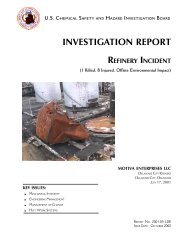CTA Report, Draft 1, ISP Review - US Chemical Safety and Hazard ...
CTA Report, Draft 1, ISP Review - US Chemical Safety and Hazard ...
CTA Report, Draft 1, ISP Review - US Chemical Safety and Hazard ...
You also want an ePaper? Increase the reach of your titles
YUMPU automatically turns print PDFs into web optimized ePapers that Google loves.
One method used blasts of high-pressure air. This cleaning process, known as “shaking the bags,” was<br />
initiated by pushing a button on a control panel in the blend room; however, this could be done only when<br />
the mat-former was not processing material. The blast of high-pressure air dislodged the dust from the<br />
bags, <strong>and</strong> it settled in the bottom of the baghouse.<br />
The second method, performed daily during shift line cleaning (Section 4.2), required <strong>CTA</strong> employees to<br />
manually strike the bags with a stick to remove the dust cake. This cleaning procedure was covered in a<br />
written Job <strong>Safety</strong> Analysis, which provided instruction on the hazards associated with cleaning the<br />
baghouse, including the risk of explosion.<br />
The residue that collected in the bottom of the baghouse could be either automatically recycled to the<br />
process or manually removed as waste during shift cleaning. If the material was recycled, it was returned<br />
to the processing line via a conveyor <strong>and</strong> then dropped through a vertical pipe containing a rotary airlock 8<br />
before being deposited into the residue feeder. In December 2002, the use of the residue feeder on line<br />
405 was discontinued because of a process change, <strong>and</strong> the baghouse residue was manually removed by<br />
dropping it through a chute. The residue fell into a cardboard box placed under the chute on the blend<br />
room floor.<br />
4.1.3 Curing Oven<br />
The mat exited the mat-former on a conveyor. Facing 9 was applied above <strong>and</strong> below the mat just prior to<br />
it entering the curing oven. Chain-driven oven flights s<strong>and</strong>wiched the mat <strong>and</strong> guided it through the oven.<br />
To reduce friction, a pneumatic pump dispensed oil rated for high-temperature use to lubricate the chains<br />
<strong>and</strong> sprockets.<br />
8 A rotary airlock is a valve that contains a set of rotating pockets that mechanically pass solids while preventing<br />
excessive return flow of air or gases. This device was necessary for the baghouse to maintain its suction.<br />
9 Facing is thin plastic nylon sheeting, which arrived at the facility on a spindle. One roll of facing was positioned<br />
above <strong>and</strong> another underneath the discharge conveyor of the mat-former.<br />
26









